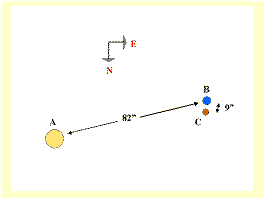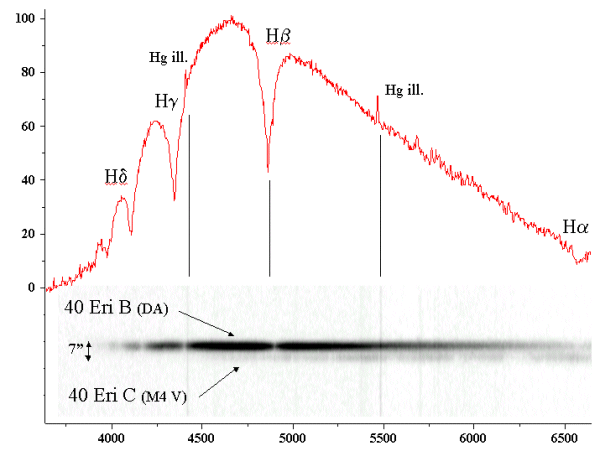PECULIAR STARS SPECTRA
White dwarfs
40 Eri B is among the few white dwarfs that are visibile with small telescopes (see the table at the bottom of this page).
But this white dwarf is easy to find because it is one of the components of the 4th mag the triple star 40 Eridani
(see picture 1).
White dwarfs are in great number, second only to M and K dwarfs, but due to their low luminosity the bright ones are
extrenely rare.
It is no surprise that they are so numerous because they results from the evolution of all the medium main sequence
stars (classes F-G-K-M).
40 Eridani is so bright because it is very close, only 16 ly, to the sun. The
principal component is a 4.5 mag K1 V star, the B component is the white dwarf with mag 9.7 and the third
component is a 10.8 mag M dwarf. The AB couple, discovered by Hershel has a 8000 years period while the BC
couple, discovered by Struve in 1851, has a shorter period of 252 years.

|
|
Picture 1: A telescopic view of the interesting triple star 40 Eridani.
|
From the orbits measurements, it resulted that the mass of B is 44% the solar mass and the mass of C is only 20% of
the solar mass. From the white dwarf spectrum (picture 2) can be calculated a blackbody temperature of 13’000 K.
As the sun (Mv=4,83) at the distance of 40 eri should be a 3,28 mag star, considering that the total emission is
proportional to the fourth power of the temperature, the ratio solar surface to B surface must be
(9.7-3.28)*2.51*(13000/5800)4= 406 times thus the radius is 1/20 of solar radius (but as B is a blue star, its total
magnitude is much higher than visual magnitude and the calculated radius reduces to 1/50 solar radii). As a
consequence, density is 15’000 times the solar density.

|
Picture 2: Spectrum of white dwarf 40 Eri B recorded on 10 feb 2004 with 10 min exposure.
Spectral resolution 5 Å, spectrograph equipped with 600 l/mm grating.
The only visible lines are due to hydrogen Balmer series, highly broadened by the extreme
surface pressure of the star. Sharp emission lines at 4348 and 5461 Å are due to Hg street lamps.
The slit was aligned along the line Eri B to Eri C so that both the spectra can be seen simultaneously
on the CCD. The difference between an M dwarf (mag 10.8) and a white dwarf (mag 9.7) is striking.
|
The spectrum in picture 2 shows only the Balmer lines and the star is classified DA, that is a class “A” Dwarf
(remember that in class A the Balmer lines reaches their maximum). Other white dwarfs show only Helium lines, with
no hydrogen and are classified as DB as in B class the He I lines are stronger. Due to the enormous gravitational
force, only the lighter element remain at the surface of a white dwarf. If some hydrogen exists, the surface will be pure
hydrogen and if the hydrogen is exhausted, the surface will be composed of pure Helium.
In the following table are listed the brightest white dwarfs in the northern emisphere.
| Common Name |
Const. |
R.A. (eq. 1950) |
Dec (eq. 1950) |
Magn. |
Dist (a.l.) |
r (Kg/cm3) |
Spect. Type |
| Sirius B | CMa | 6h 42'55" | -16° 40' | 8,3 | 8,6 | 3600 | DA |
| 40 Eri B | Eri | 4h 13'04" | -7° 44,1' | 9.5 | 15.7 | 330 | DA |
| Procyon B | CMi | 7h 36'42" | +5° 21' | 10.7 | 11.4 | 500 | --- |
| Feige 34 | UMa | 10h 36'41" | +43° 21.8' | 11.1 | 55 | --- | DO |
| W1346 | Cyg | 20h 32'14" | +24° 54' | 11.5 | 45 | 500 | --- |
| EG 247 | Cam | 5h 01'30" | +52° 46' | 11.8 | 140 | 90 | --- |
| He 3 | Aur | 6h 44'15" | +37° 35.1' | 12.0 | 60 | 1400 | --- |
| EG 368 | Dra | 16h 47'38" | +59° 8.7' | 12.2 | 40 | 400 | --- |
| Van Maanen | Psc | 0h 46'31" | +5° 9.2' | 12.4 | 14 | 500 | DZ |
| EG 180 | Cam | 4h 26'47" | +58° 53.9' | 12.4 | 18 | 600 | --- |
 Go back to Peculiar Star Home Page Go back to Peculiar Star Home Page
|
|



 Go back to Peculiar Star Home Page
Go back to Peculiar Star Home Page